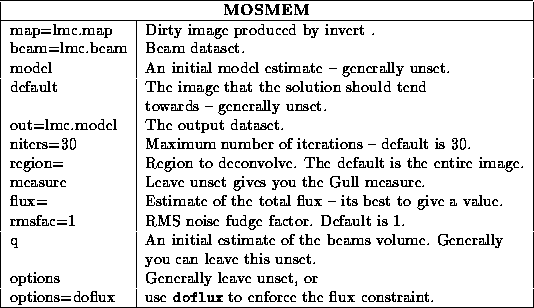



Next: Self-Calibration
Up: The Joint Approach
Previous: Imaging -- INVERT
MIRIAD
contains two tasks to deconvolve
the mosaiced dirty images produced by invert
.
In terms of theory, practical use
and indeed internal implementation, these tasks are quite similar
to the deconvolution tasks described in Chapter 13. The major
difference is that the `convolution' operation (which turns a prospective
model into a dirty image) is somewhat more involved. Also account must
be made of the changing noise level across the dirty image.
The two mosaic deconvolution tasks are mosmem
, which implements a
maximum-entropy-based deconvolution algorithm, and task mossdi
, which
uses a Steer, Dewdney & Ito (SDI) CLEAN algorithm. Generally mosmem
is superior. Task mossdi
can be very slow for all but very extended
emission, and its results can be poor. Note that, although you can
make mosaiced, multi-frequency synthesis images with invert
(and, indeed,
produce a mosaiced, spectral dirty beam), there is no
mosaic equivalent to mfclean
. In deconvolving a mosaiced,
multi-frequency image you will have to tactically assume that the
spectral index is 0. This should not be a problem -- primary beam model
errors are probably more significant than spectral errors in these
deconvolutions.
If you are deconvolving, note the recommendations for invert
's
imsize parameter, and the use of options=double.
If you are familiar with the inputs to the conventional deconvolvers,
the inputs to mosmem
and mossdi
should be fairly
straightforward. In the case of the inputs to mosmem
and maxen
,
apart from differences in the options, the meaning of the flux
keyword and the default region, the only significant difference is in
specifying
the expected RMS noise level in the dirty image. Because the noise level
varies across the dirty image, mosmem
uses the theoretically
expected noise level (which it computes) times a user-specified
fudge factor, rmsfac. That is, if rmsfac is
set at 1
(the default), then mosmem
uses the theoretical
noise level when calculating its  statistic.
statistic.
Typical inputs to mosmem
are:

The inputs and use of mossdi
should be equally simple
for someone familiar with clean
. Given that the task is
not recommended, it will not be discussed further.
Having produced a model, we generally want to convolve this
with a Gaussian CLEAN beam and add in the deconvolution
residuals. This is done by restor
.
The inputs and use of restor
is identical to a conventional observation
(restor
is the only general task which is smart enough to recognise
a mosaiced experiment directly). Task restor
uses a constant
CLEAN beam -- it is not a function of position. The only caveat is that,
when determining
a default CLEAN beam, restor
fits a Gaussian to the synthesised
beam which corresponds to the first pointing. Provided the first
pointing is a fairly typical pointing, this will probably be adequate.
Otherwise
you may wish to use task mospsf
(see Section 20.6.5 below)
to generate an actual point-spread function (at some position) and then
use imfit
to determine Gaussian parameters for it.
Typical inputs to restor
are:





Next: Self-Calibration
Up: The Joint Approach
Previous: Imaging -- INVERT
Last generated by rsault@atnf.csiro.au on 16 Jan 1996
 statistic.
statistic.

